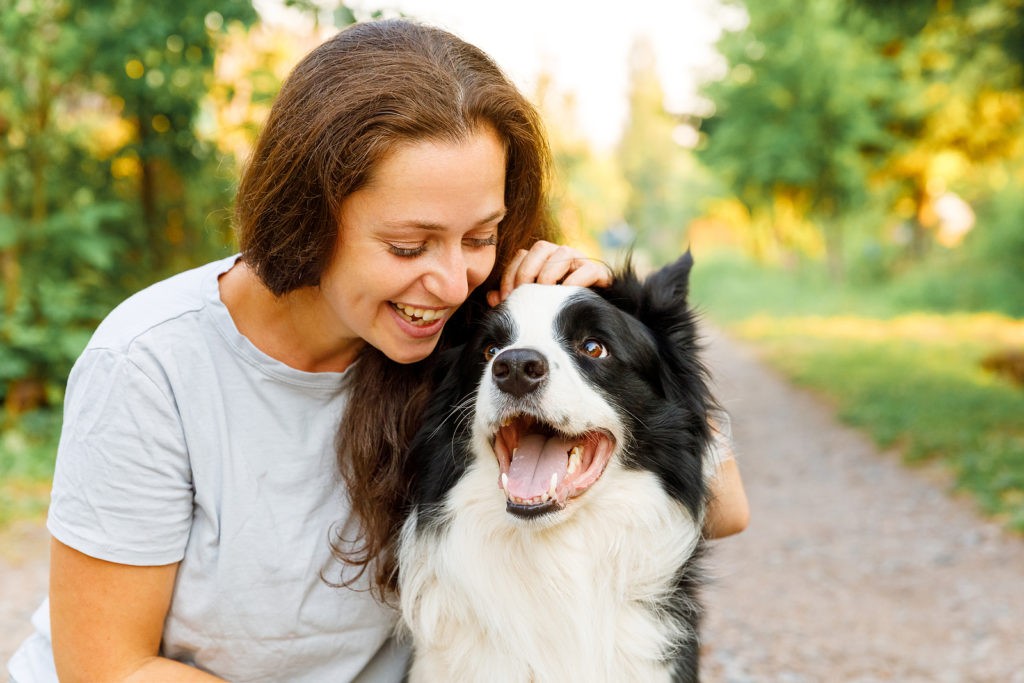Petting a dog is often an instinctive reaction for humans. Whether it’s a gentle pat on the head or a full-body rub, this simple act seems to bridge a gap between species. But have you ever stopped to wonder, “Why Do Dogs Like To Be Pet?” It’s easy to assume they enjoy it because they seem to lean into our touch and often solicit it. However, delving deeper into canine behavior reveals fascinating reasons behind this beloved interaction.
While many animals are wary of physical touch from others, particularly different species, dogs stand out. Their eagerness for physical affection and interaction is a trait that has evolved alongside their unique relationship with humans. Understanding why dogs enjoy being pet not only enriches our bond with them but also helps us ensure we are interacting in ways they truly appreciate.
 A person petting a brown and white dog on the head outdoors, showcasing the bond between humans and dogs through physical affection.
A person petting a brown and white dog on the head outdoors, showcasing the bond between humans and dogs through physical affection.
The Science of Snuggles: Oxytocin and Bonding
At the heart of a dog’s enjoyment of petting lies a powerful hormone: oxytocin. Often dubbed the “love hormone” or “bonding hormone,” oxytocin plays a crucial role in social attachment and positive emotions. Research has demonstrated that when dogs are petted and receive attention from humans, their brains release oxytocin. This surge of oxytocin creates feelings of pleasure and strengthens the bond between dog and human.
Interestingly, this hormonal exchange is not one-sided. Studies have also shown that petting a dog can increase oxytocin levels in humans as well. This mutual release of oxytocin underscores the deeply reciprocal nature of the human-dog bond, where physical affection plays a vital role in emotional connection for both species. It’s a biological mechanism that reinforces the positive feedback loop of interaction and companionship.
Where are the Sweet Spots? Best Places to Pet Your Dog
While the desire to be pet is generally widespread among dogs, preferences for where they like to be petted can vary. Individual dogs may have their own unique favorites, and context also matters – a dog might be more receptive to petting in a familiar environment with a trusted person. However, there are some generally preferred zones that most dogs tend to enjoy.
Chest, Neck, and Shoulders
For many dogs, the chest, neck, and shoulders are prime petting locations. These areas are often easily accessible and less vulnerable than other parts of their body. Starting with gentle scratches in these regions is generally a safe bet, especially when interacting with a dog you are just getting to know. These areas are associated with comfort and security, making them ideal for initiating positive physical interaction.
Ears (with Caution)
The ears are packed with nerve endings, making them potentially very pleasurable to have rubbed or scratched. This nerve density can trigger the release of oxytocin and other feel-good hormones. However, this sensitivity also means that some dogs can be apprehensive about ear handling, fearing potential discomfort or pain.
When approaching a dog’s ears, it’s essential to be gentle and observant. Approach slowly, and carefully monitor the dog’s body language. If the dog seems tense, pulls away, or shows signs of discomfort, it’s best to respect their boundaries and choose a different petting location.
Belly (When Offered)
If a dog rolls onto their back, exposing their belly, it’s often interpreted as an invitation for a belly rub. This vulnerable posture indicates a high level of trust and comfort. However, it’s crucial to understand the nuance of this behavior. Not all belly presentations are requests for rubs. Some dogs might expose their belly as a sign of submission or appeasement, especially if they feel intimidated.
When a dog offers their belly in a relaxed context – perhaps they are playful, relaxed, and making eye contact – then it’s likely a genuine invitation for a belly scratch. Always approach with gentle hands and watch for signs of enjoyment, such as a relaxed body, soft eyes, and perhaps even a happy sigh.
Decoding Doggy Reactions to Petting
Understanding why dogs like to be pet is only part of the equation. It’s equally important to recognize how dogs communicate their enjoyment – or discomfort – during petting sessions. Paying attention to canine body language is key to ensuring these interactions are positive and respectful.
The Leg Shake Reflex
Many dog owners are amused and intrigued by the involuntary leg shaking or kicking that sometimes occurs when scratching a dog in a particular spot. This seemingly quirky behavior is actually a simple reflex arc. Stimulating certain nerves, often in the belly or flank area, triggers a signal to the spinal cord, which in turn causes the leg to kick.
While this reflex is often harmless and even entertaining to observe, it’s important to remember it’s an involuntary reaction. A dog doesn’t consciously choose to shake their leg, and some dogs might be startled or confused by this lack of control over their own body. If a dog seems bothered by the leg shaking, it’s best to adjust your petting to a different area.
Head Pats: Handle with Care
While depicted frequently in popular culture, head pats are not universally loved by dogs, particularly pats on the top of the head. For many dogs, the top of the head is a vulnerable area. Reaching over their head can be perceived as a potentially threatening gesture, especially from someone unfamiliar. Dogs who are naturally timid or have had negative experiences might be particularly sensitive to head pats.
Unless you know a dog well and are confident they enjoy head pats, it’s generally safer to err on the side of caution. Opt for petting under the chin, on the chest, or shoulders instead, especially during initial interactions.
Sleeping Dogs: Let Them Rest
Even if a dog seems to enjoy being petted while awake, interrupting their sleep for petting is generally not appreciated. Just like humans, dogs need restful sleep, and disruptions can be jarring and unwelcome. Waking a dog abruptly to pet them can startle them, and in some cases, especially with dogs who are easily startled or possessive of their space when resting, it could even elicit a negative reaction like a snap.
While gentle petting of a sleeping dog you know well might be acceptable, it’s generally best to let sleeping dogs lie. Respect their need for undisturbed rest and reserve petting for when they are awake and receptive.
Petting for Calm: Soothing an Anxious Pup
Beyond simply being enjoyable, petting can be a powerful tool for calming anxious or stressed dogs. The release of oxytocin associated with petting can have a genuinely soothing effect, helping to counteract the physiological effects of stress. When a dog is feeling anxious, gentle, rhythmic petting in preferred areas like the chest or shoulders can help to lower their heart rate and promote relaxation.
However, it’s important to recognize that petting is not a cure-all for anxiety. While it can provide comfort and temporary relief, it’s crucial to address the root cause of a dog’s anxiety. Petting can be a valuable component of a broader strategy that may also include removing the stressor, providing a safe space, or using other calming techniques.
Petting Etiquette: Dos and Don’ts for Happy Dogs
To ensure that petting interactions are positive and enjoyable for both you and your dog, consider these etiquette guidelines:
- Do: Approach gently and let the dog sniff your hand first.
- Do: Pet slowly and avoid sudden movements.
- Do: Pay attention to body language. Relaxed posture, leaning in, and soft eyes indicate enjoyment.
- Do: Respect boundaries. If a dog pulls away, stiffens, or shows signs of discomfort like lip licking or whale eye (showing the whites of their eyes), stop petting.
- Don’t: Force petting on a dog who is uninterested or fearful.
- Don’t: Pet over the top of the head of unfamiliar dogs.
- Don’t: Disturb a sleeping dog for petting.
- Don’t: Assume all belly presentations are invitations for rubs.
FAQ: Common Questions About Petting Dogs
Why do dogs enjoy being pet?
Dogs enjoy being pet primarily because it triggers the release of oxytocin, the bonding hormone, fostering feelings of pleasure and strengthening their bond with humans. It also mimics grooming behaviors from puppyhood, providing comfort and security.
Are there specific areas where dogs prefer to be pet?
Yes, generally dogs prefer being pet on their chest, shoulders, neck, and sometimes belly (when offered). Individual preferences vary, so observe your dog’s reactions.
Can petting help with a dog’s behavioral issues?
Petting can help reduce anxiety and stress-related behavioral issues by promoting relaxation. It can also be used as a positive reinforcement during training.
Is there a right way to pet a dog?
Yes. Approach gently, let them sniff you, pet slowly, and always monitor their body language to ensure they are comfortable and enjoying the interaction.
Do all dogs like to be pet?
While most dogs enjoy petting, individual preferences vary. Some dogs might be less receptive due to temperament, past experiences, or simply personal preference. Always respect a dog’s individual boundaries.
How often should I pet my dog?
There’s no set rule, but regular affectionate touch strengthens your bond. Pet your dog daily based on their comfort and your available time, ensuring it’s quality interaction.
What signs indicate a dog is enjoying being pet?
Signs of enjoyment include relaxed body posture, leaning into your touch, soft eyes, a wagging tail, and sometimes even closing their eyes in contentment.
Are there any times when I should avoid petting my dog?
Avoid petting a dog when they are eating, sleeping, agitated, or showing signs of illness or pain. Also, respect their space if they seem withdrawn or uninterested in interaction.
Conclusion: Petting with Purpose and Respect
Petting is far more than just a casual gesture for dogs; it’s a deeply meaningful interaction rooted in biology and social connection. Understanding why dogs like to be pet empowers us to interact with them in ways that are truly beneficial and enjoyable for them. By paying attention to their preferences, respecting their boundaries, and recognizing the nuances of canine communication, we can transform simple petting sessions into powerful moments of bonding, comfort, and mutual affection, further enriching the remarkable relationship we share with our canine companions.
